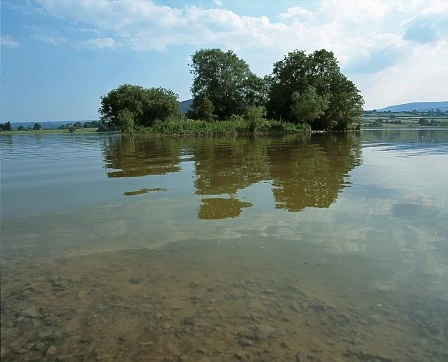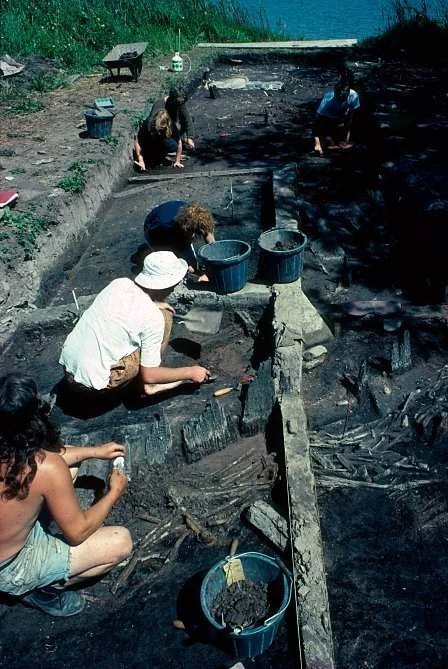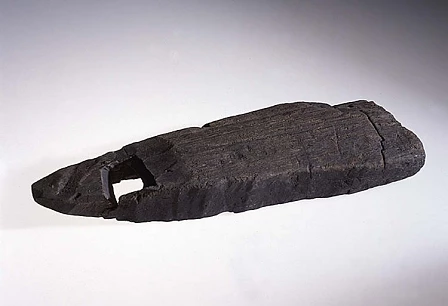The Palace in the Lake
Llan-gors Lake, with crannog in background. Image: Cadw (Crown Copyright).
Llan-gors crannog during excavation. This image of the 1991 excavations shows planks from the crannog's palisade wall.
Oak plank from Llan-gors, 60cm (2 foot) long. Submerged oak planks like this formed part of the palisade around Llan-gors crannog.
Reconstruction of Llan-gors crannog, based on the excavation.
Excavations at the artificial island or crannog in Llan-gors Lake, near Brecon, have provided a unique glimpse of a royal Welsh court.
Excavations between 1989 and 1993 by the National Museum Wales and Cardiff University have revealed that the crannog, the only one known in Wales, was an early medieval royal site of the ruler of the inland kingdom of Brycheiniog.
The small early kingdom of Brycheiniog (Brecheiniauc) corresponded approximately to the historical county of Brecknockshire in south Wales. The territory took its name from Brychan, dynastic founder of the royal line according to later legend..
Irish influence
The crannog was carefully constructed of brushwood and sandstone boulders, reinforced and surrounded by several lines of oak plank palisade. Tree-ring dating of the well-preserved timbers has established that they were felled between AD889 and AD893. The site seems to have been influenced by Irish building techniques, and was possibly constructed with the assistance of an Irish master craftsman.
The kings of Brycheiniog claimed to be descended from a part-Irish dynasty, and their use of such an unusual and impressive construction may have enhanced their political standing and strengthened their claims to Irish ancestry.
Objects of high quality
As a royal site Llan-gors crannog would have been a centre of administration, as well as a place for hospitality, where the ruler seasonally held court, received tribute and indulged in hunting and fishing. The artefacts uncovered, which include embroidered textile and parts of a portable shrine, confirm the site's aristocratic status.
The crannog is attacked
The Anglo-Saxon Chronicle records that in AD916 Æthelflaed, 'Lady of the Mercians', sent an army into Wales three days after the murder of Abbot Ecgberht and his companions. The army destroyed Brecenanmere (the Anglo-Saxon name for Llan-gors Lake) and captured 'the king's wife and thirty-three other persons'. This record of an attack probably refers to the crannog, and the capture of the wife of king Tewdwr ap Elisedd. During excavation, a charred, burnt layer was uncovered - probably representing this attack.
The site gives an unique glimpse of life on a royal site in the late 9th and early 10th-centuries.
Timeline
- 880s: Elise ap Tewdwr, ruler of Brycheiniog forced by the aggressive actions of Gwynedd to seek overlordship of Alfred the Great.
- 889-93: Llan-gors crannog constructed by the ruler of Brycheiniog.
- 894: Vikings ravaged Brycheiniog.
- 916: Brecenanmere (probably Llan-gors crannog) destroyed by Mercian (Anglo-Saxon) army.
Background Reading
'On a crannoge, or stockaded island, in Llangorse Lake, near Brecon' by E. N. Dumbleton. In Archaeologia Cambrensis (4th series) vol. 1, p2-98 (1870).
'The early medieval crannog at Llangorse, Powys: an interim statement on the 1989-1993 seasons'. In The International Journal of Nautical Archaeology vol. 23, p189-205 (1994).




Comments - (2)
Dear David Morgan,
Thank you very much for your enquiry. Our Senior Curator of Archaeology has contacted you to inform you that the full excavation report is due for publication in October 2019.
Best wishes,
Marc
Digital Team
With thanks,
David Morgan